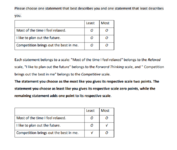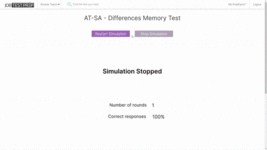The ATSA Test Prep includes ATSA practice tests fine-tuned to closely mimic each and every part of the FAA ATC Test, and enhance the skills needed to succeed in it. It includes:
- ATSA Memory Games Practice- improve the ability to mentally hold and update numbers and equations, with an unlimited number of questions in the exact ATSA test format.
- ATSA Spatial/Visual Relationship Practice- practice quickly recognizing the relation between two presented airplanes.
- ATC Collision Avoidance Simulation Practice- prevent aircraft collision while simultaneously tackling challenging math drills, by practicing infinite scenarios in the same format as the ATSA, and more difficult simulations that make the actual test feel much easier.
- ATSA Logical Reasoning & Reading Comprehension Mock Tests- practice accurately answering questions on time in two of the most challenging tests in terms of time pressure.
- Full-Length Personality Test
| Word Problems - Logical Reasoning |
This subtest contains approximately 15 questions that must be answered in around 20 minutes. You will be penalized for not answering all the questions.
For a two-day career event at a local high-school class, exactly six out of eight parents with different occupations - florist, gardener, historian, inventor, jeweler, locksmith, mailman, and optician - are chosen to introduce their occupations to the class. On each day exactly three different parents will speak to the class in three different time slots - morning, mid-day and afternoon, subject to the following conditions:
A. Day 1: inventor, gardener, historian Day 2: jeweler, locksmith, optician B. Day 1: mailman, florist, gardener Day 2: optician, jeweler, inventor C. Day 1: jeweler, optician, gardener Day 2: inventor, florist, historian D. Day 1: inventor, historian, jeweler Day 2: optician, mailman, locksmith E. Day 1: historian, optician, locksmith Day 2: mailman, jeweler, inventor |
| Personality Test |
This subtest has 108 questions. You are given a list of three statements, and you must determine which of the three is most like you and which is least like you. |
| Reading Comprehension |
| This subtest contains 18 questions that must be answered in 15 minutes. You are presented with six paragraphs, each followed by three questions. Questions may ask you to determine the main point of the paragraph or which statement is true. The Passage: Experts agree that arts and culture are an important part of the economy, but the precise relationship is complicated. The main question is does investment in the arts stimulate growth, or are the arts the product of economic development? It would seem that the case for continued arts funding is clear-cut—enjoying the arts (visiting art galleries and theatres) boosts the economy. Yet some argue that the link between arts investment and economic output is tenuous. Researchers today are exploring a different angle of this relationship. They are trying to understand how the subjective value of the arts—the 'happiness factor'—may translate into economic benefits. According to the “happiness factor” hypothesis, when a place develops a critical mass of arts and vibrancy it tends to attract talented people which, in turn, tends to raise income. Which of the following assumptions can definitely be made based on the above paragraph? A) Subsidizing cultural activities leads to economic growth. B) The "happiness factor" effect on the economy is still unclear. C) Economic development contributes to the establishment of the arts. D) The "happiness factor" focuses on the influence of talented artistic people on the economy. |



